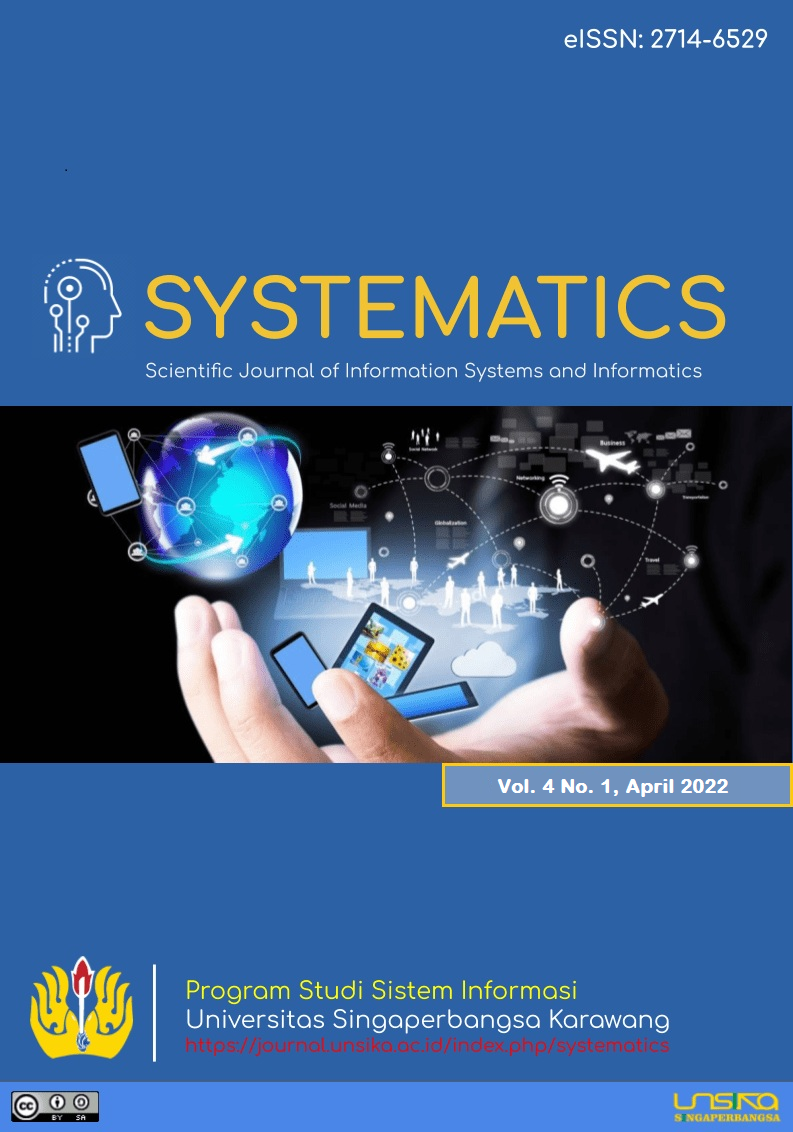Prediction of Student Graduation Accuracy Using C45 Algorithm (Case Study: Fasilkom Unsika)
Prediksi Ketepatan Kelulusan Mahasiswa Menggunakan Algoritma C45 (Studi Kasus: Fasilkom Unsika)
DOI:
https://doi.org/10.35706/sys.v4i1.6307Abstract
The Faculty of Computer Science at University Singaperbangsa Karawang has had problems in the last 3 years, namely the low level of accuracy of graduation. The number of students from the 2013 batch graduated on time as many as 43 out of 349. In 2014 51 out of 343 graduated on time. In 2015 there were 79 students graduating on time or 49%. The purpose of this study is to perform data mining using the C4.5 algorithm on Weka tools to determine the classification of student graduation determination. So that research is carried out to facilitate the determination of graduation. The distribution of training and testing data is carried out in 5 categories, namely 90:10, 80:20, 70:30, 60:40, 50:50 to find out the best results from the dataset comparison category. The results of the study show that the best accuracy values are 90% training data and 10% testing data with an accuracy value of 84.2% and an ROC value of 0.852. Based on the results of the highest accuracy and ROC values, so it has a better and more accurate model.
Downloads
References
Suhardjono, W. Ganda, and H. Abdul, “Prediksi Waktu Kelulusan Mahasiswa Menggunakan Svm Berbasis Pso,” Bianglala Inform., vol. 7, no. 2, pp. 97–101, 2019.
V. A. Nurislamiaty et al., “Prediksi Kelulusan Mahasiswa Fakultas Teknologi Informasi Umby Menggunakan Metode Decision Tree Penerapan Algoritma C4.5 Student Graduation Prediction Faculty Of Information Technology Umby Using The Decision Tree Method Of C4.5 Algorithm Application,” pp. 1–8.
A. Rohman and S. Mujiyono, “Permodelan Prediksi Predikat Kelulusan Mahasiswa Menggunakan Decision Tree C4 . 5,” vol. II, no. 2, pp. 1–5, 2021.
L. Y. Lumban Gaol, M. Safii, and D. Suhendro, “Prediksi Kelulusan Mahasiswa Stikom Tunas Bangsa Prodi Sistem Informasi Dengan Menggunakan Algoritma C4.5,” Brahmana J. Penerapan Kecerdasan Buatan, vol. 2, no. 2, pp. 97–106, 2021, doi: 10.30645/brahmana.v2i2.71.
Menteri Pendidikan dan Kebudayaan, Salinan_PERMENDIKBUD-3-TAHUN-2020. 2020.
M. N. Yatimah, “Implementasi Data Mining untuk Prediksi Kelulusan Tepat Waktu Mahasiswa STIMIK ESQ Menggunakan Decision Tree C4.5,” JUMANJI (Jurnal Masy. Inform. Unjani), vol. 5, no. 2, p. 89, 2021, doi: 10.26874/jumanji.v5i2.95.
M. Goldman, Ian. and Pabari, “No 主観的健康感を中心とした在宅高齢者における 健康関連指標に関する共分散構造分析Title,” vol. 6, no. 10, 2021.
I. N. Kholifah, “Memprediksi Tingkat Kelulusan Peserta Kursus Per- tahun dengan Algoritma Data Mining C4 . 5 dan RapidMiner,” Juisi, vol. 06, no. 01, 2020.
F. Ali Ma, A. Pratama, I. Sholihin, and A. Rizki Rinaldi, “Penerapan Model Prediksi Menggunakan Algoritma C.45 Untuk Prediksi Kelulusan Siswa SMK Wahidin,” vol. 1, no. 1, pp. 16–20, 2021.
T. Faizah and A. Jananto, “Perbandingan Algoritma C4 . 5 Dan Id3 Untuk Prediksi,” Jatisi, vol. 8, no. 2, pp. 980–990, 2021.
F. S. Sulaeman and M. A. Rilmansyah, “Aplikasi Penerapan Algoritma C45 untuk Memprediksi Kelulusan Mahasiswa Berbasis Web,” J. Media Tek. Sist. Ind., vol. 5, no. 1, pp. 41–54, 2021.
R. P. S. Putri and I. Waspada, “Penerapan Algoritma C4.5 pada Aplikasi Prediksi Kelulusan Mahasiswa Prodi Informatika,” Khazanah Inform. J. Ilmu Komput. dan Inform., vol. 4, no. 1, p. 1, 2018, doi: 10.23917/khif.v4i1.5975.
C. Algoritma, D. Prediksi, and K. Mahasiswa, “Implementasi pso untuk optimasi bobot atribut pada algoritma c4.5 dalam prediksi kelulusan mahasiswa,” vol. 06, pp. 416–423, 2021.
E. P. Rohmawan, “Menggunakan Metode Desicion Tree,” J. Ilm. MATRIK Vol.20 No.1, April 201821-30, pp. 21–30, 2018.
A. Voutama, “Perancangan Aplikasi M-Discussion Berbasis Android Sebagai Wadah Diskusi Sekolah,” Syntax J. Inform., vol. 7, no. 2, pp. 116–124, 2018.
A. K-means and R. M. Sagala, “Prediksi Kelulusan Mahasiswa Menggunakan Data mining Prediction of college subject using K-means Algorithm in Data mining,” pp. 131–142.
L. Genisa and D. I. Mulyana, “Implementasi Penerapan Metode C4. 5 dan Naïve Bayes Dalam Tingkat Kelulusan Akreditasi Lembaga PAUD Pada Badan Akreditasi Nasional,” J. Media …, vol. 5, pp. 1595–1604, 2021, doi: 10.30865/mib.v5i4.3267.
M. I. A. Vachroni and A. Hermawan, “Prediksi kelulusan mahasiswa menggunakan metode backpropagation,” Univ. Teknol. Yogyakarta, vol. 4, pp. 230–238, 2021.
A. Voutama, I. Maulana, and N. Ade, “Interactive M-Learning Design Innovation using Android-Based Adobe Flash at WFH (Work From Home),” Sci. J. Informatics, vol. 8, no. 1, pp. 127–136, 2021, doi: 10.15294/sji.v8i1.27880.
A. Voutama and E. Novalia, “Perancangan Aplikasi M-Magazine Berbasis Android Sebagai Sarana Mading Sekolah Menengah Atas,” J. Tekno Kompak, vol. 15, no. 1, p. 104, 2021, doi: 10.33365/jtk.v15i1.920.
Downloads
Published
How to Cite
Issue
Section
License
Copyright (c) 2022 SYSTEMATICS

This work is licensed under a Creative Commons Attribution-ShareAlike 4.0 International License.
Authors who publish with this journal agree to the following terms:
- Authors retain copyright and grant the journal right of first publication with the work simultaneously licensed under a Creative Commons Attribution-ShareAlike 4.0 International License. that allows others to share the work with an acknowledgement of the work's authorship and initial publication in this journal.
- Authors are able to enter into separate, additional contractual arrangements for the non-exclusive distribution of the journal's published version of the work (e.g., post it to an institutional repository or publish it in a book), with an acknowledgement of its initial publication in this journal.
- Authors are permitted and encouraged to post their work online (e.g., in institutional repositories or on their website) prior to and during the submission process, as it can lead to productive exchanges, as well as earlier and greater citation of published work (See The Effect of Open Access).







